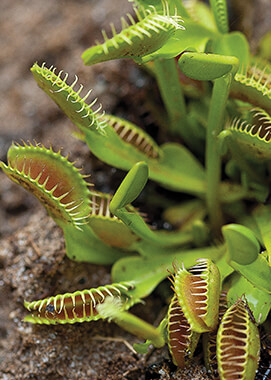OVERVIEW
The Venus flytrap is one of a kind. Nectar in its "traps"—actually modified leaves—attracts insects. When an unsuspecting insect brushes against tiny trigger hairs on a leaf-trap though, the trap snaps shut in less than a second. Once the trap is tightly closed, digestive acids and enzymes dissolve the insect, and the plant absorbs the nutrient-rich "soup." Seven to ten days later, the trap opens, ready for another meal.
Rather than wasting energy on falling raindrops or other inedible objects, a Venus flytrap tracks the number of times the insect trips its tiny hairs before activating its digestive juices. A trap’s trigger hairs must be struck twice within a 20-second time frame for the trap to snap shut.
Like other plants, Venus flytraps photosynthesize: they get energy from the sun. So why do they trap and digest insects? The answer is in the soil. Most plants take in nutrients from the soil: nitrogen, sulfur, phosphorous, magnesium, calcium, and potassium are particularly important. Most plants can't survive in wet, acidic soil because it lacks adequate nutrients. But Venus flytraps aren't "most plants"! They have adapted to living in this poor soil, obtaining most of the nutrients they need from the insects and other small animals they capture.
CULTIVATION

Today, Venus flytraps are cultivated in greenhouses, and they are popular potted plants. New plants grow from seeds, but flytraps also send out horizontal, underground stems that develop into new plants—clones of the parent plant. Clones can be split off from parent plants to start new Venus flytraps.
To stay healthy, Venus flytraps need the same conditions as those in their natural habitat: poor, acidic soil; wet roots; high humidity; and full sun. Saturating the soil with deionized water is important; tap water contains trace minerals that will cause the plants to decline or die. During the growing season, a Venus flytrap needs only a couple of small bugs or slugs each month. Plants go dormant and die back in the winter, but new growth sprouts in spring.
Like breeds of dogs, cultivated varieties (called cultivars) are the same species, but they are propagated specifically for certain characteristics, such as size and color. Growers have developed dozens of cultivars, with colorful names like "Maroon Monster," "Jaws," "Werewolf," and "Giant Clam."
CONSERVATION
While the Venus flytrap is a successful hunter, it faces threats of its own.
Much of its wetland habitat has been converted for urban development; fire suppression has altered the environment, and for years collectors dug up and sold the botanical wonders. The result is that these unique plants are endangered. With a range of only a 100-square-mile area in North and South Carolina, a single disaster could threaten the existence of the natural, wild population.
There is hope, however. All remaining Venus flytrap habitat is protected: the land is owned and managed by The Nature Conservancy, the North Carolina government, or the US military. But poaching (illegal collection) remains a threat. If you decide to grow a Venus flytrap, you can help by purchasing your plant or seeds from a reputable grower.









0 Comments